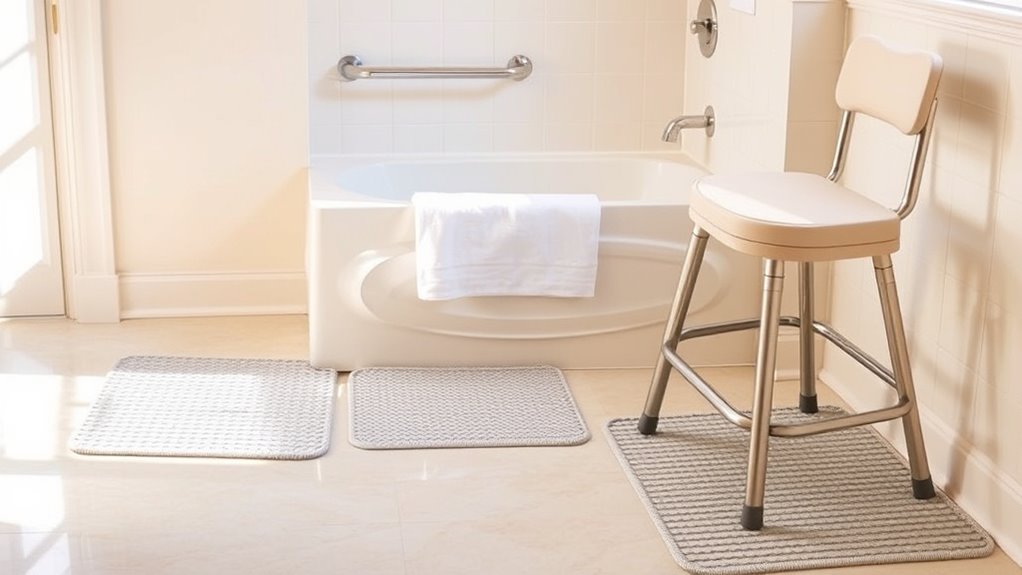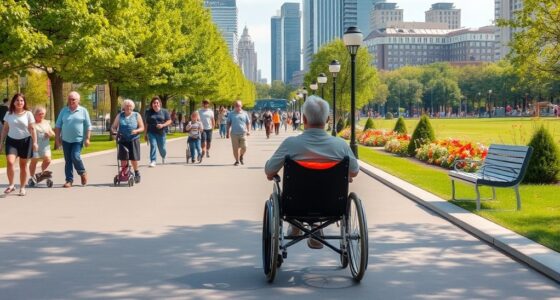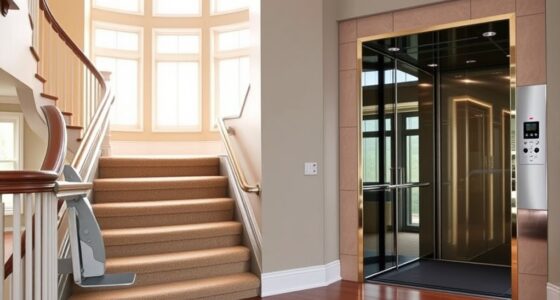To make your bathroom safer today, start by ensuring it’s well-lit with motion sensors or night lights. Use non-slip mats and stickers on floors and in the shower to prevent falls. Keep clutter organized and within easy reach, so items aren’t scattered and cause trip hazards. Install grab bars without tools for added stability. Adjust the water temperature to prevent burns, and include a shower seat for comfort. Improving ventilation and teaching household members safety tips can make a big difference—keep going to learn even more easy safety tips.
Key Takeaways
- Keep walkways clear of clutter and use non-slip mats to prevent slips and falls.
- Install grab bars and support devices that are easy to attach without tools.
- Use night lights and motion sensors for better visibility during nighttime visits.
- Set water heater temperature to a safe level and regularly test hot water before use.
- Organize frequently used items within easy reach to reduce reaching and bending hazards.
Keep the Bathroom Well-Lit
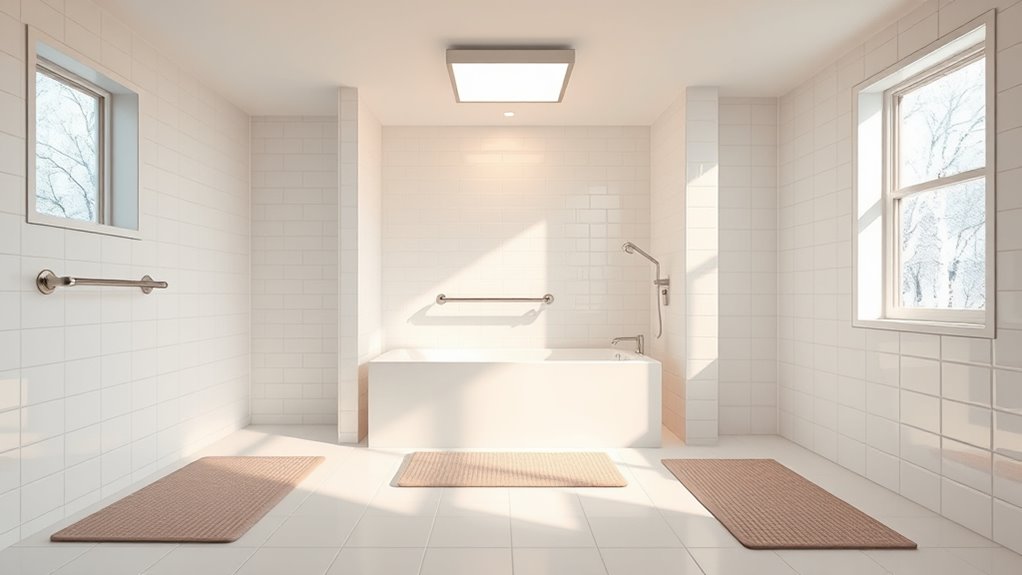
A well-lit bathroom is essential for safety and preventing accidents. Installing motion sensors ensures the light turns on automatically when you enter, eliminating the need to fumble for switches in the dark. This quick response helps you avoid slips or bumps, especially during nighttime visits. Night lights are another effective solution; they provide gentle illumination without disturbing your sleep or overwhelming your eyes. Place them strategically around the sink, toilet, or along the floor to improve visibility. Bright, consistent lighting helps you see hazards clearly, reducing the risk of falls or injuries. Proper lighting quality is crucial for creating a safe environment, as it enhances overall visibility and reduces shadows that can hide potential hazards. Additionally, using appropriate lighting solutions can further improve safety by ensuring even light distribution throughout the space. Good lighting design also minimizes glare and shadows, making it easier to spot obstacles. Ensuring that light fixtures are installed at the correct height and angle can help prevent shadows and glare, further enhancing safety. Incorporating professional lighting installation can ensure optimal placement and function of fixtures. Prioritizing proper illumination makes your bathroom safer, especially for children, seniors, or anyone with impaired vision. With motion sensors and night lights, you create a safer, more accessible space effortlessly.
Use Non-Slip Mats and Stickers
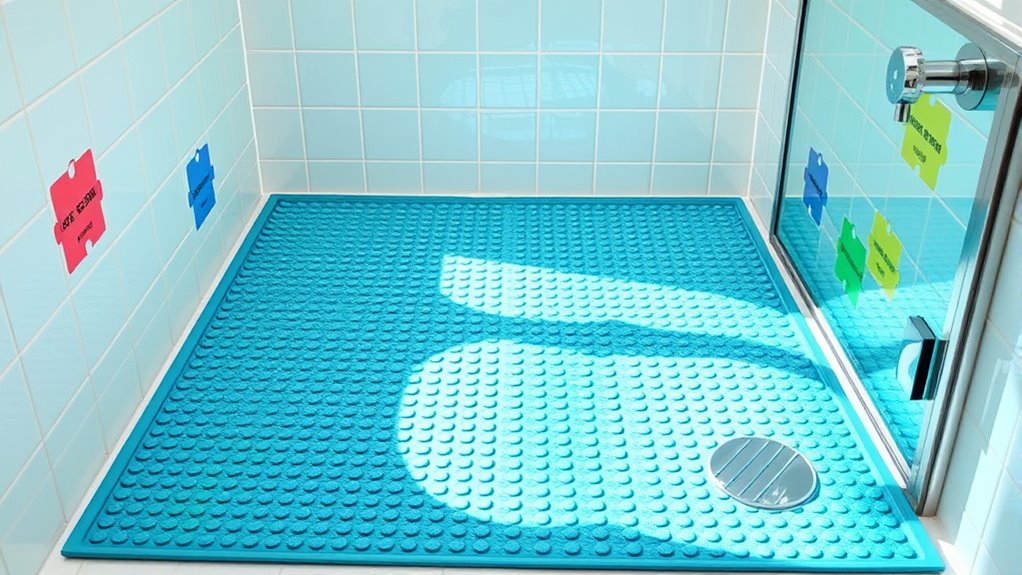
To prevent slips and falls in your bathroom, it’s important to use non-slip mats and stickers strategically. These items directly address slip hazards by providing better traction in wet areas. Place non-slip mats inside the shower or tub and on the bathroom floor where water tends to collect. Stickers or adhesive strips can be added to slippery surfaces like tiles or glass doors to further enhance grip. By improving traction, you reduce the risk of accidental falls, especially for seniors or those with mobility concerns. Regularly check the condition of mats and stickers, replacing them if they become worn or lose effectiveness. Simple, proactive steps like these make your bathroom safer without extensive modifications. Understanding shower safety features and proper installation techniques can also help prevent accidents and improve overall bathroom safety. Additionally, selecting dog names that match the environment or your pet’s personality can contribute to a more comfortable and familiar space for everyone. Incorporating non-slip surfaces in other areas of your home can further enhance safety and peace of mind.
Organize and Clear Clutter
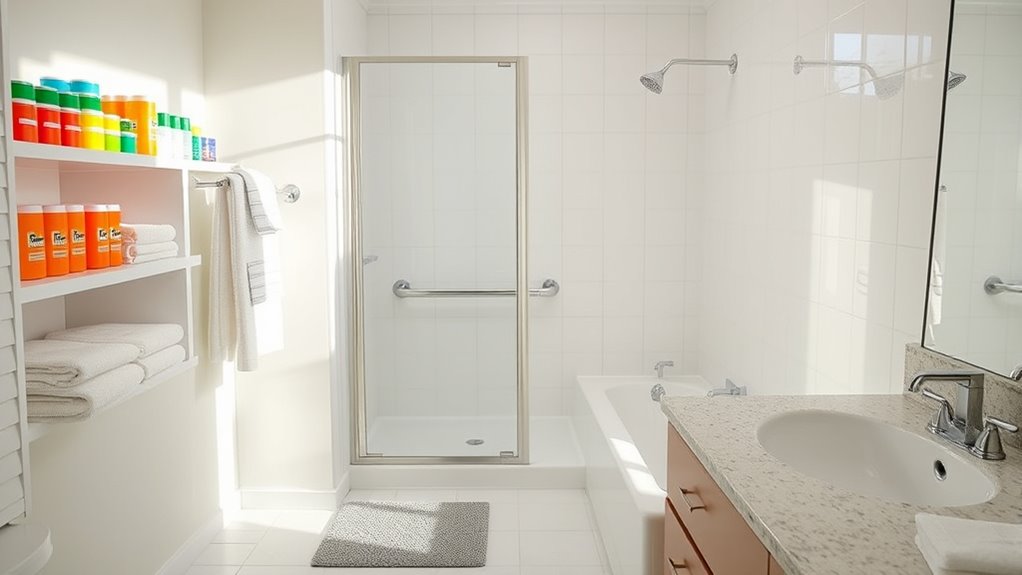
Keeping your bathroom organized and free of clutter is a simple yet effective way to prevent accidents. Clutter management reduces the risk of slips, trips, and falls by keeping walkways clear and essential items accessible. Use smart storage solutions like shelves, baskets, and cabinets to keep toiletries, towels, and cleaning supplies neatly stored away. Regularly assess your space to eliminate items you no longer need or use. This not only creates a safer environment but also makes cleaning easier. Remember, a clutter-free bathroom promotes better hygiene and reduces stress. Focus on practical storage options that suit your routine and ensure everything has a designated place. By maintaining an organized space, you can enjoy a safer, more functional bathroom every day. Implementing storage solutions can further enhance safety and accessibility.
Install Grab Bars Without Tools
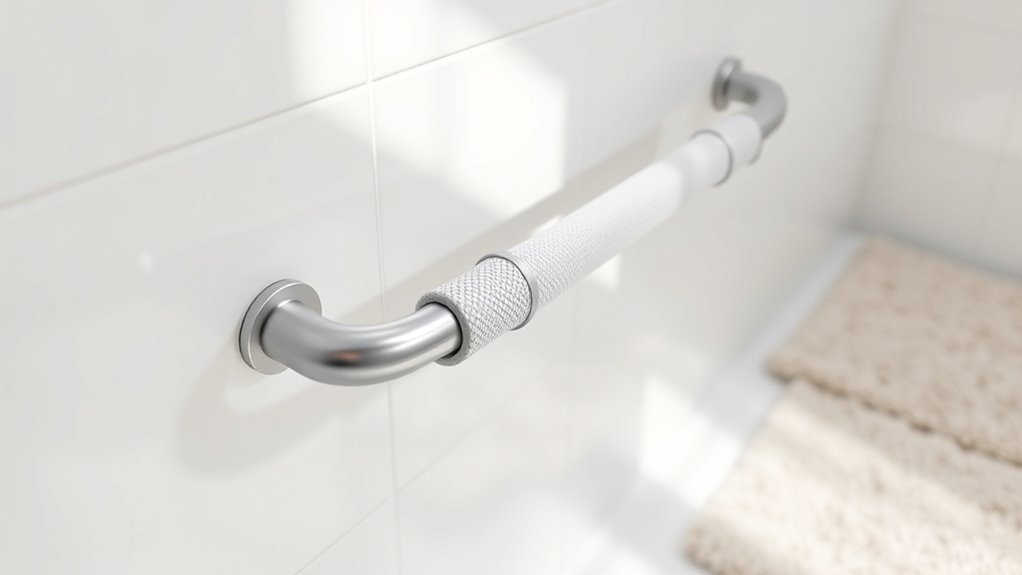
Installing grab bars without tools is a practical way to enhance bathroom safety, especially if you want a quick, mess-free solution. Tool-free installation offers convenience and flexibility, making it easy to add support where needed. Suction cup grab bars are an excellent option because they attach securely to smooth surfaces like tiles or glass without drilling or screws. To install, simply clean the surface thoroughly, press the suction cups firmly into place, and ensure they’re sealed properly. These grab bars provide immediate stability, helping prevent slips and falls, especially in showers and near toilets. Keep in mind, however, that suction cup grab bars are best for temporary or less-traffic areas, as they may need occasional re-sealing. This simple upgrade can make a significant difference in bathroom safety today. Additionally, understanding tableware materials can help select the best accessories for your bathroom or dining area.
Adjust Water Temperature Settings
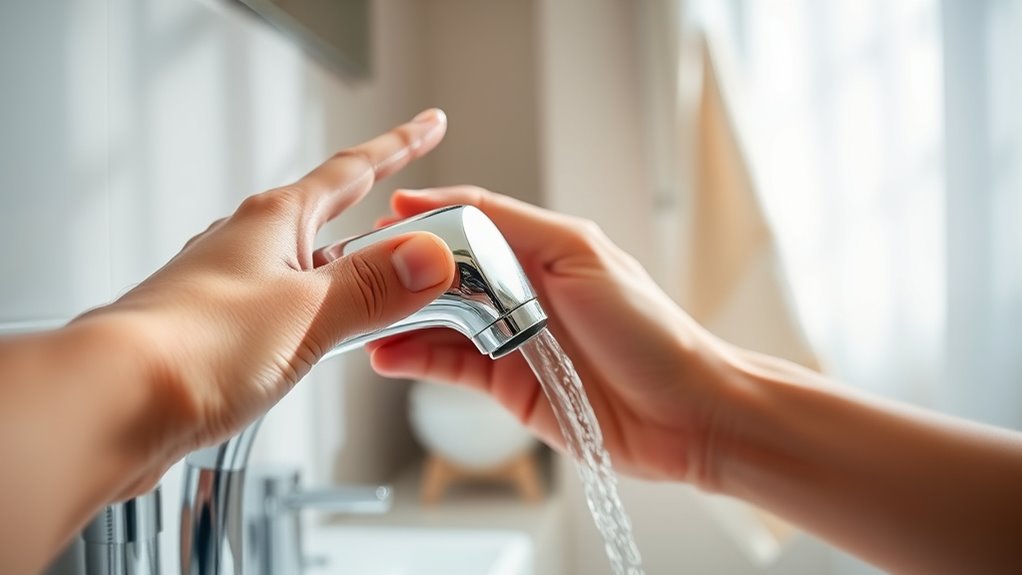
You should set a maximum temperature limit on your water heater to prevent scalding. Regularly test the water temperature to guarantee it stays safe, especially if you have children or elderly family members. Make sure everyone in your home understands the risks and how to adjust the settings safely. Monitoring hydration and nutrition can also help in managing water use and preventing accidents. Incorporating sound vibrations into your routine may promote relaxation and reduce stress, contributing to overall safety. Additionally, being aware of water temperature regulation methods can help maintain consistent and safe water conditions throughout your household. Staying informed about automation in business innovations can also inspire smarter safety solutions at home.
Set Maximum Temperature Limit
Adjusting your water heater to set a maximum temperature limit is a simple but effective way to prevent scalding accidents in the bathroom. Use the thermostat control to lower the water temperature to a safe level, typically around 120°F. Installing safety caps on your water heater can help prevent accidental adjustments, especially if you have children or elderly family members. Additionally, vetted products like safety caps are available to enhance protection and ensure consistent safety measures. Regularly inspecting your water heater and upgrading safety features can further reduce risks and improve overall bathroom safety. Being aware of best beaches and their amenities can also encourage safer, more enjoyable experiences in coastal areas.
Regularly Test Water Heat
Since water temperatures can fluctuate over time, it’s important to regularly test your water heater to guarantee it remains at a safe setting. Regular water heater maintenance helps ensure the temperature stays within a safe range, preventing scalding risks. You should monitor the water temperature periodically by running the hot water and using a thermometer to check the actual temperature. Ideally, it should be around 120°F (49°C). If it’s higher, adjust the thermostat accordingly. Consistent temperature monitoring allows you to catch any irregularities early and maintain a safe bathing environment. Making this a routine part of your water heater maintenance can considerably reduce the chance of burns or accidents, especially for children or seniors in your household.
Educate Family on Risks
Have you explained the risks of high water temperatures to your family members? Raising risks awareness helps prevent burns and scalds. Safety training guarantees everyone understands how to set the water heater properly. Educate your family on:
- The importance of checking water temperature before use
- How to adjust the water heater to safe levels
- Recognizing signs of scalding hazards
Use Shower Seats or Benches
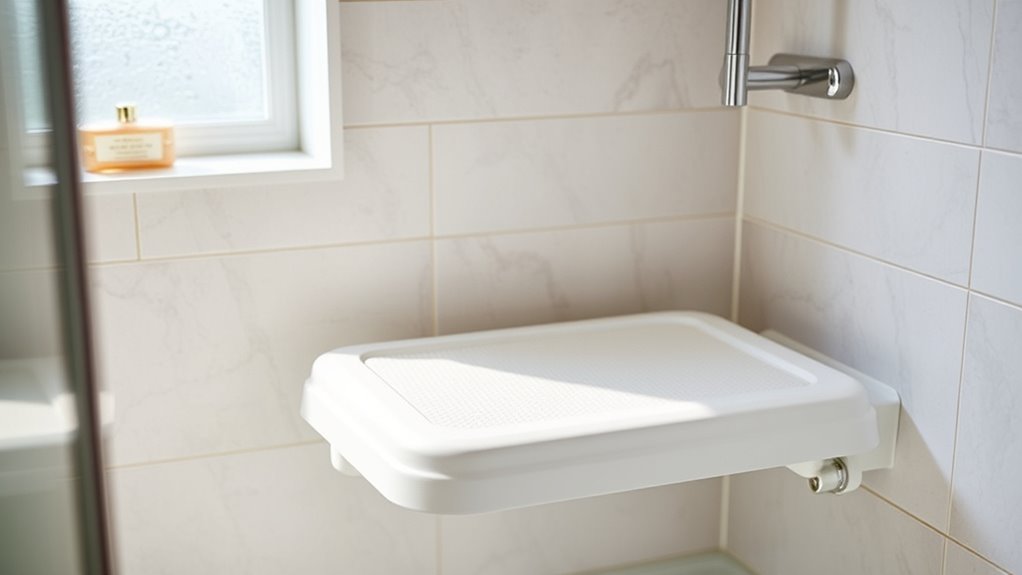
Using shower seats or benches can considerably reduce the risk of slips and falls in the bathroom. They provide stability and comfort, making bathing safer and more accessible. Padded shower seats offer extra comfort, especially for longer showers, while foldable benches save space when not in use. These options support your independence and confidence, reducing anxiety about slipping.
| Comfort Level | Ease of Use | Space Saving |
|---|---|---|
| Soft padding | Simple to install | Fold away easily |
| Extra comfort | Stable seating | Fits in small bathrooms |
| Reduces falls | Supports mobility | Convenient storage |
| Confidence boost | Safe bathing | Versatile options |
| Independence | User-friendly | Perfect for limited space |
Place Items Within Easy Reach
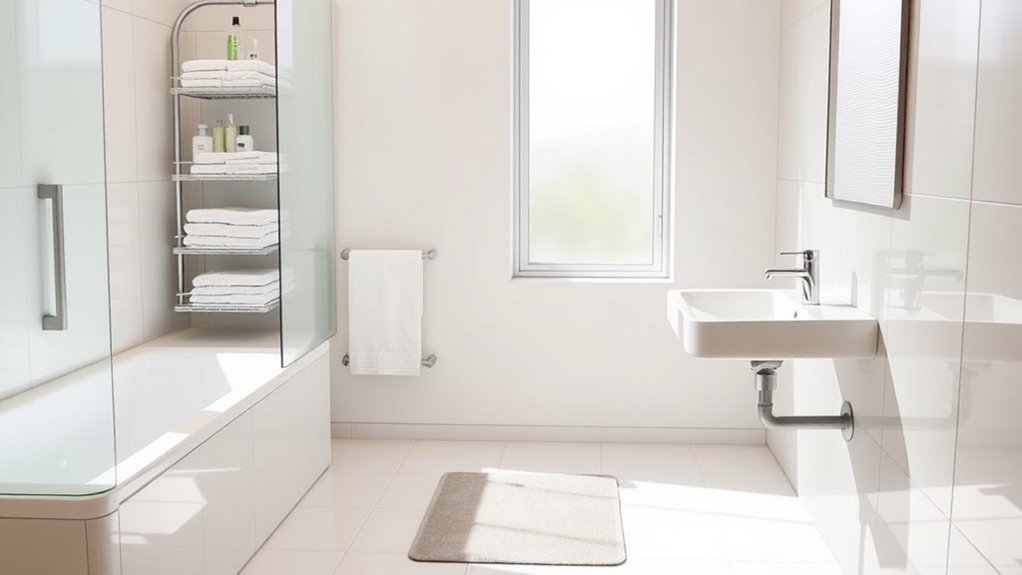
Keep your most-used items organized in accessible storage solutions so you don’t have to reach or bend awkwardly. Place frequently used products, like soap and towels, within easy reach to prevent accidents. This simple step can make your bathroom safer and more convenient.
Accessible Storage Solutions
Ever wonder how to make your bathroom safer and more accessible? Proper storage solutions help prevent accidents and reduce clutter. Use accessible shelves and cabinets placed at waist level to keep everyday items within easy reach. Label storage compartments clearly to avoid unnecessary rummaging, which can cause spills or falls. To enhance safety further, consider:
- Using overflow prevention measures to stop water from pooling on floors
- Installing labeled bins to organize toiletries and keep them accessible
- Choosing open shelving for frequently used items to minimize reaching or bending
These simple adjustments keep essentials close, minimize hazards, and promote a safer bathroom environment. Thoughtful storage not only improves safety but also makes your daily routine more efficient.
Organize Frequently Used Items
To make your bathroom safer and more convenient, focus on organizing your frequently used items within easy reach. Use countertop organization to keep daily essentials like soap, toothbrushes, and skincare within arm’s reach, so you don’t have to search or stretch. Place your most-used items in accessible spots, avoiding clutter that could cause accidents. Consider installing a small tray or caddy on the countertop to keep everything tidy and easy to find. Regularly review your daily item placement to ensure only necessary items are within reach, reducing the risk of knocking things over or tripping. Clear, simple organization helps you move quickly and safely, especially when your hands are full or you’re in a hurry.
Ensure Proper Ventilation

Proper ventilation is essential for maintaining a safe and healthy bathroom environment. Good airflow helps improve air quality and controls humidity, reducing mold growth and slipping hazards. To guarantee proper ventilation, consider installing an exhaust fan or keeping windows open after showers. Regularly cleaning vents prevents dust buildup and maintains efficiency. You should also monitor humidity levels and use dehumidifiers if necessary.
Proper bathroom ventilation ensures safety, reduces mold, and keeps air fresh and healthy.
Remember, ventilation isn’t just about comfort—it’s about safety. Key points include:
- Improving air quality by removing pollutants and odors
- Managing humidity to prevent mold and mildew
- Promoting a dry environment that reduces slip hazards
Prioritizing ventilation helps keep your bathroom safe, fresh, and free from moisture-related problems.
Educate Household Members on Safety Practices
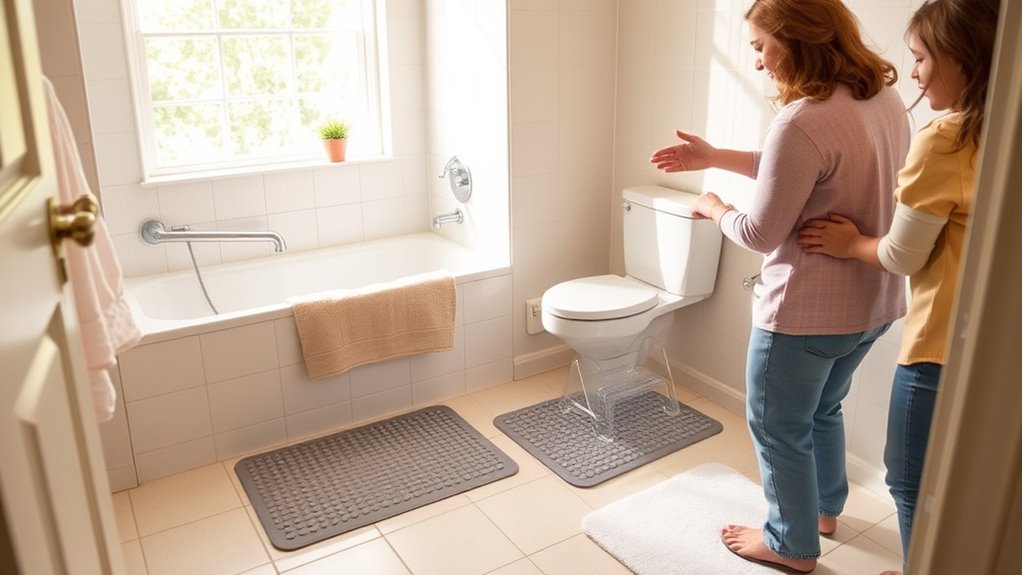
Educating household members about safety practices is essential for maintaining a secure bathroom environment. You should teach everyone how to handle fire safety, such as keeping flammable items away from heat sources and knowing how to use a fire extinguisher. Make certain they understand the importance of quick emergency response, like calling for help if someone slips or gets injured. Encourage regular reminders about turning off electrical appliances after use to prevent fires. Discussing emergency procedures ensures everyone knows what to do in case of accidents. By fostering awareness of these safety practices, you reduce risks and create a safer bathroom for all household members. Clear communication about fire safety and emergency response is a crucial step toward injury prevention.
Frequently Asked Questions
How Can I Prevent Slips During Bathing?
To prevent slips during bathing, you should focus on safety measures like using non-slip mats in your bathtub or shower. Additionally, grab bar installation provides extra support and stability. These simple, non-technical solutions make a big difference in reducing fall risks. Always make certain mats are securely placed and grab bars are properly installed to maximize safety. Taking these steps helps you bathe more confidently and prevents accidents.
What Are the Best Ways to Keep Faucets Safe?
To keep faucets safe, start by faucet childproofing to prevent accidental scalds or leaks. Install faucet covers or knob guards for added protection, especially if kids are around. Regularly check for faucet leak prevention by inspecting for drips or leaks and fixing them promptly to avoid water damage. These simple steps help make sure your bathroom remains safe and functional without requiring technical solutions.
How Do I Maintain Bathroom Safety for Elderly Users?
To maintain bathroom safety for elderly users, you should install grab bars near the toilet and shower to prevent falls. Use non-slip mats on the floor to reduce slipping hazards, especially when surfaces are wet. Make sure fixtures are secure and within easy reach, and keep the bathroom well-lit. Regularly check for hazards, and encourage the use of assistive devices to create a safer environment.
Can Plants Improve Bathroom Safety and Ambiance?
Imagine transforming your bathroom into a lush indoor garden, where natural decor creates a calming atmosphere. Plants can improve safety by reducing slips, as their presence encourages careful navigation and adds visual cues for edges and obstacles. Indoor gardening not only enhances decor but also promotes a soothing environment, making your bathroom safer and more inviting. Incorporate easy-care plants to enjoy these benefits without extra hassle.
Are There Any Safety Tips for Children in the Bathroom?
When considering safety tips for children in the bathroom, you should always prioritize bathroom supervision to prevent accidents. Installing childproof locks on cabinets and toilets keeps dangerous items out of reach. Keep sharp objects and cleaning supplies stored safely away. Teach your children about bathroom safety, and never leave them unattended. These simple steps help create a safer environment, reducing risks and giving you peace of mind while your kids are in the bathroom.
Conclusion
By taking these simple steps today, you’re making your bathroom safer, but the real change starts with you. Imagine walking in tomorrow, feeling confident and secure, knowing you’ve minimized risks. What if a small adjustment could prevent a fall or injury? The power is in your hands—don’t wait. Start now, and see how just a few simple changes can transform your everyday routine into a safer, more confident experience.
